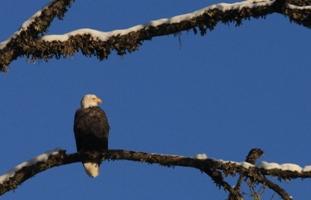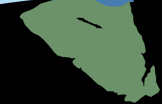2023 Salmon Run Programs - BC Parks Foundation
BC Parks Foundation is excited to offer salmon education programs at the Goldstream Nature House with our Discover Parks Ambassador team.

Help Us Spread the Word: It is very important that this learning opportunity is available to all children, and local businesses have come together as part of the Goldstream Chums Sponsorship Program to provide the funding to help keep these programs
affordable!
The Goldstream Nature House needs your support more than ever after being closed for much of the past three years and BC Parks Foundation is working to rebuild and revive this wonderful community treasure.
For more information on how you or someone you know can become a Goldstream Chum and help send children to the salmon run, please click here.
These 1- 1.25 hour school programs run Mon-Fri, from late-October to early December beginning every half hour at the Nature House from 9am to 2pm. Registration is on a first-come first-served basis through our online registration system. **1 class per program** Review our salmon run programs below, then when registration opens, register online via the link that will be provided here - Each program is a minimum of a $125 donation. We have had to increase the donation amount due to the rapidly increasing costs of staffing. If the donation amount is prohibitive please contact us at This email address is being protected from spambots. You need JavaScript enabled to view it..
 |
Salmon Storybook Time Gr. K-2 BIG IDEAS: Observable featurures/Lifecycles and Adaptations
|
LS's covered |
 |
The Chum Salmon Cycle Gr. 3-5 BIG IDEAS: Lifecycles and Adaptations/Survival/Diversity of living things/Interactions and Ecosystems
|
LS's covered |
 |
The Salmon Forest Gr. 4-9 BIG IDEAS: Lifecycles/Adaptations/Survival and diversity/Interactions and Ecosystems/Matter Cycles
|
LS's covered |
 |
Eddie The Eagle and the Estuary Gr. K-7 (Available late November/Early December) BIG IDEAS: Observable features/Lifecycles and Adaptations/Survival/Interactions and Ecosystems |
Previous Curriculum Learning Standards met by our Salmon Run Programs
|
Salmon Storybook Gr. K-2 |
Kindergarten |
LS's: Science- Describe basic needs and adaptations of local animals. Living things make changes to accommodate daily and seasonal changes. Social Studies- Will know people, places and events in the local community and know rights, roles and responsibilities of individuals and groups. Physical Education– Demonstrate caring behavior in groups and how to participate in different types of physical activities. Demonstrate proper technique for performing specific locomotor movement - Identify safety; follow rules and directions when participating in activities. English Language Arts– Demonstrate oral language and metacognitive strategies by asking questions as an aid to understand while listening, or viewing. Demonstrate abilities to follow simple oral instructions.- Interact with others, speak in turn and listen actively, providing verbal and non-verbal responses appropriate to their stages of development and to their cultures. |
|
Grade 1 |
LS’s: Science- Classify living and non-living things. Name local plants and animals. Name the structural features of living things in the local environment. Know the behavioural adaptations of animals in the local community. Social Studies- Will know people, places and events in the local community and know rights, roles and responsibilities of individuals and groups. Understand the relationships between community and its environment. Know natural and human-made features of the local environment. Physical Education– Demonstrate caring behavior in groups and how to participate in different types of physical activities. Demonstrate proper technique for performing specific locomotor movement - Identify safety; follow rules and directions when participating in activities. English Language Arts– Demonstrate oral language and metacognitive strategies by asking questions as an aid to understand while listening, or viewing. Demonstrate abilities to follow simple oral instructions.-Interact with others, speak in turn and listen actively, providing verbal and non-verbal responses appropriate to their stages of development and to their cultures. |
|
|
Grade 2 |
LS’s: -Science- Classify and compare the lifecycles of different organisms. Compare the similarities and differences between offspring and adults. Understand local living things have lifecycles and are adapted to their ecosystems including watersheds. Social Studies - Understand the relationships between people and the local environment. Physical Education– Move through defined space while maintaining control (walking blind-folded).-Change level of body position while maintaining control. English Language Arts– Demonstrate reading strategies, oral language and metacognitive strategies by asking questions as an aid to understand while listening, or viewing. Demonstrate abilities to follow simple oral instructions.-Interact with others, speak in turn and listen actively, providing verbal and non-verbal responses appropriate to their stages of development and to their cultures. |
|
|
Chum Salmon Cycle Gr.3-5 |
Grade 3 |
LS’s: -Science– Understand that living things are diverse, can be grouped and interact with their ecosystems. Examine the biodiversity I the local environment. Social Studies - Understand the relationships between humans and their environments. Physical Education– Move through defined space while maintaining control (walking blind-folded). Change level of body position while maintaining control. English Language Arts– Demonstrate reading strategies, oral language and metacognitive strategies by asking questions as an aid to understand while listening, or viewing. Demonstrate abilities to follow simple oral instructions.-Interact with others, speak in turn and listen actively, providing verbal and non-verbal responses appropriate to their stages of development and to their cultures. |
|
Grade 4 |
LS’s: Science- Analyze that all living things sense and respond to their environment.Physical Education– Identify opportunities for activity in a variety of settings.-Demonstrate an ability to participate safely in specific activities.- Demonstrate leadership in selected activity. English Language Arts– Demonstrate reading strategies, oral language and metacognitive strategies by asking questions as an aid to understand while listening, or viewing. Demonstrate abilities to follow simple oral instructions.-Interact with others, speak in turn and listen actively, providing verbal and non-verbal responses appropriate to their stages of development and to their cultures. |
|
|
Grade 5 |
LS’s: Science– Analyze how multicellular organisms have organ systems that enable them to survive and interact with their environment. Physical Education– Identify opportunities for activity in a variety of settings.-Demonstrate an ability to participate safely in specific activities.- Demonstrate leadership in selected activity. English Language Arts– Demonstrate reading strategies, oral language and metacognitive strategies by asking questions as an aid to understand while listening, or viewing. Question what they hear and read to further enhance their understanding. |
|
|
Salmon Forest Gr. 4-9 |
Grade 4 |
LS’s: Science- Analyze that all living things sense and respond to their environment. systems. Physical Education– Identify opportunities for activity in a variety of settings.-Demonstrate an ability to participate safely in specific activities.- Demonstrate leadership in selected activity. English Language Arts– Demonstrate reading strategies, oral language and metacognitive strategies by asking questions as an aid to understand while listening, or viewing. Demonstrate abilities to follow simple oral instructions.-Interact with others, speak in turn and listen actively, providing verbal and non-verbal responses appropriate to their stages of development and to their cultures. |
|
Grade 5 |
LS’s: Science– Analyze how multicellular organisms have organ systems that enable them to survive and interact with their environment. Physical Education– Identify opportunities for activity in a variety of settings.-Demonstrate an ability to participate safely in specific activities.- Demonstrate leadership in selected activity. English Language Arts– Demonstrate reading strategies, oral language and metacognitive strategies by asking questions as an aid to understand while listening, or viewing. Question what they hear and read to further enhance their understanding. |
|
|
Grade 6 |
LS’s: Science– Analyze how multicellular organisms rely on their internal systems that enable them to survive, reproduce and interact with their environment. Physical Education– Identify opportunities for activity in a variety of settings. Demonstrate an ability to participate safely in specific activities. Demonstrate leadership in selected activity. English Language Arts– Demonstrate reading strategies, oral language and metacognitive strategies by asking questions as an aid to understand while listening, or viewing. Use questioning, predicting, summarizing, and inferring to accomplish specific purposes for viewing and listening. Use information they have heard or viewed to develop questions and activities that will extend their understanding. Locate and interpret details to answer specific questions or complete tasks. Demonstrate a willingness to assume a variety of roles in group interactions. |
|
|
Grade 7 |
LS’s: Science- Analyze how organisms have evolved over time as well as their survival needs Understand that the diversity and survival of living things has changed over time, by natural selection. Physical Education– Demonstrate/apply safe procedures for specific physical activities. English Language Arts– Interpret details in simple and direct illustrations and other required representations.-Share the responsibility for the effective functioning of groups. Encourage others to participate. |
|
|
Grade 8 |
LS's: Science- Interpret characteristics of life processes. Physical Education– Demonstrate/apply safe procedures for specific physical activities. English Language Arts– Interpret details in simple and direct illustrations and other required representations. Share the responsibility for the effective functioning of groups. Encourage others to participate. |
|
|
Grade 9 |
LS’s: -Science- Analyze the different matter cycles and the biotic and abiotic components of a variety of ecosystems. Physical Education– Demonstrate/apply safe procedures for specific physical activities .English Language Arts– Interpret details in simple and direct illustrations and other required representations. Share the responsibility for the effective functioning of groups. |


















